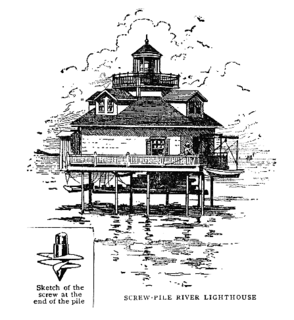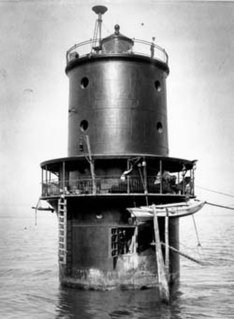
A screw-pile lighthouse is a lighthouse which stands on piles that are screwed into sandy or muddy sea or river bottoms. The first screw-pile lighthouse to begin construction was built by the blind Irish engineer Alexander Mitchell. Construction began in 1838 at the mouth of the Thames and was known as the Maplin Sands lighthouse, and first lit in 1841. However, though its construction began later, the Wyre Light in Fleetwood, Lancashire, was the first to be lit.

The Baltimore Harbor Light, officially Baltimore Light and historically Baltimore Harbor Lighthouse is a privately owned caisson lighthouse in the Chesapeake Bay in Maryland. First lit in 1908, it sits at the mouth of the Magothy River, marking the channel which leads northwest to the opening of the Patapsco River, which then leads into the Baltimore harbor. At the time of its construction, it was the world's tallest caisson lighthouse. In June 2006, Baltimore Light was sold at auction to private owners by the General Services Administration for $260,000; the U.S. Coast Guard maintains rights to operate a light on the structure.

Point No Point Light, located in the Chesapeake Bay off the eponymous point several miles north of the mouth of the Potomac River, was constructed as part of a program to add lighted navigational aids in a thirty-mile stretch of the bay between Cove and Smith Points.

The Pungoteague Creek Light was a small screwpile lighthouse constructed in the Chesapeake Bay in 1854. Destroyed in 1856, it had the shortest recorded existence of any lighthouse on the Bay, and possibly the United States, at just 459 days.

Newport News Middle Ground Light is a lighthouse near the Monitor-Merrimac Memorial Bridge-Tunnel on Interstate 664 in Hampton Roads. It is the oldest caisson lighthouse in Virginia.

The Sharps Island Light is the third lighthouse to stand nearly 3 miles (5 km) south-southwest from the southern end of Tilghman Island in Maryland's Chesapeake Bay. The structure is best known today for evoking the Leaning Tower of Pisa, a condition caused by an ice floe in 1977.

Solomons Lump Light is a lighthouse in the Chesapeake Bay, the abbreviated remains of a caisson light built in 1895. That structure replaced a screw-pile light built on the same spot in 1875, which in turn superseded the Fog Point Light.

Pooles Island Light is the oldest lighthouse still standing in Maryland and the fourth oldest in the Chesapeake Bay area. The light is located on Pooles Island in the central Chesapeake Bay.

Bloody Point Bar Light is an early sparkplug lighthouse in the Chesapeake Bay near Kent Island, Maryland.

The Choptank River Light was a screw-pile lighthouse located near Oxford, Maryland. In its second incarnation it was the only such light moved from another location in the Chesapeake Bay.

The Hooper Island Light is a lighthouse in the Chesapeake Bay, west of Middle Hooper Island in Maryland.

Love Point Light was a screw-pile lighthouse in the Chesapeake Bay, off the northern end of Kent Island, Maryland.

Wolf Trap Light is a caisson lighthouse in the Virginia portion of the Chesapeake Bay, about seven and a half miles northeast of New Point Comfort Light. It is listed on the National Register of Historic Places.

New Point Comfort Light is a lighthouse in the Virginia portion of the Chesapeake Bay, United States, off the tip of the Middle Peninsula. Finished in 1804, it is the third-oldest surviving light in the bay, and the tenth-oldest in the United States.

Thimble Shoal Light is a sparkplug lighthouse in the Virginia portion of Chesapeake Bay, north of the Hampton Roads channel. The third light at this location, it is listed on the National Register of Historic Places.

The White Shoal Light was a lighthouse located in the James River near Newport News, Virginia. It outlasted all other lighthouses in the James, finally succumbing to ice in the 1970s.
The Windmill Point Light was a lighthouse located at the mouth of the Rappahannock River.

Smith Point Light is a caisson lighthouse in the Virginia portion of the Chesapeake Bay at the mouth of the Potomac River. It was added to the National Register of Historic Places in 2002.

The Bowlers Rock Light was a lighthouse located in the Rappahannock River in Virginia.



















